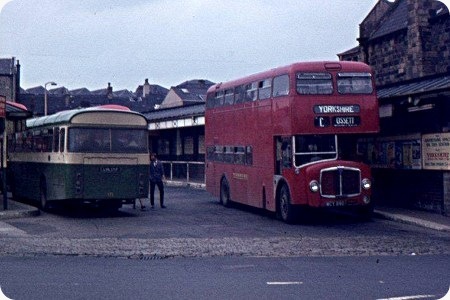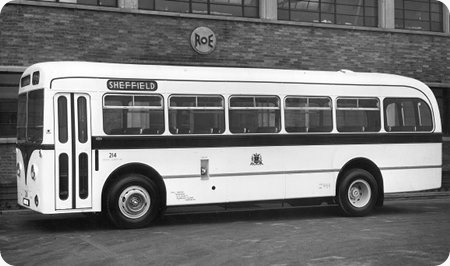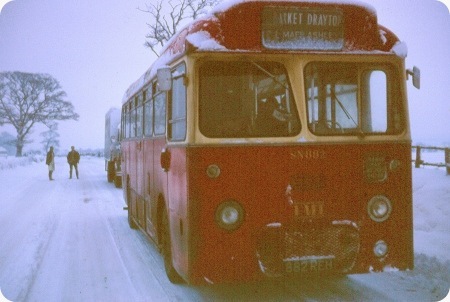South Wales – AEC Bridgemaster – WCY 890 – 1210
South Wales Transport
1960
AEC Bridgemaster 2B3RA
Park Royal H43/29F
Now here is a shot of a bus somewhat out of its area, the photo of this South Wales Bridgemaster was taken in July 1969, in Dewsbury Bus Station. At the time it was working on Yorkshire Woolen district routes you can see the top blind displaying ‘Yorkshire’. I am not sure why YWD would need to hire/buy something so non-standard as the above for their fleet – shortage of vehicles for some reason perhaps or late delivery of new ones?
I would be interested to know the answer – no doubt someone will know and let me know.
Also in view is a 1967 West Riding Marshall B51F bodied Leyland Panther PSUR1/1 registration LHL 171F fleet number 171.
Photograph and Copy contributed by Bob Gell
04/04/11 – 07:04
At the time Yorkshire Woollen had a severe vehicle crisis. In addition to the Bridgemasters from South Wale some vintage Bristol Ks from West Yorkshire were also acquired. In addition a number of former Sheffield C fleet buses also entered service these were PD2s with Roe and ECW bodywork and some early Atlanteans all tended to be used on local area routes in Dewsbury
Chris Hough
04/04/11 – 07:07
The reason why Yorkshire Woollen had these Bridgemasters was due to a severe shortage of buses.Later Bristol K double deckers were acquired from West Yorkshire and United Auto.
Philip Carlton
05/04/11 – 05:30
Thanks, Chris and Philip, for confirming that YWD needed to buy additional vehicles because of a shortage of buses. I think most enthusiasts know they had those problems, but how and why did they occur? Every operator’s fleet needs eventually to be replaced, and YWD would, (or certainly should), have had a well-established renewal programme, as did all BET companies. That was standard policy throughout the group. So what caused the ‘severe crisis’?
Roy Burke
08/04/11 – 05:00
Chris and Philip Thanks for the answer to my query – as you probably guessed, this was taken at the same time as the West Yorkshire K5G already posted.
Bob Gell
24/11/15 – 06:08
With regard to Roy Burke’s comment, the reason these things occur is generally twofold firstly manufacturers delivering buses late; secondly and particularly when the old CoF system was in operation a larger number of buses than that planned for could need replacing.
Of course the third reason is rarer but most to be feared: prohibitions on running vehicles by the Traffic Commissioner.
Some fleets seem more prone to vehicle shortage than others. at SMT/SOL/Eastern Scottish it seemed to be endemic.
Here we are talking about Yorkshire Woollen and I have a captcha ending in HD.
Stephen Allcroft
17/02/16 – 05:53
I am of an age that remembers the South Wales Bridgemasters coming to Yorkshire Woollen. The first one I saw was on the B&C services to Ossett from Fir Cottage and as someone who loves AEC buses and (Regent Vs) and still does it was hard to work out what was going until a really nice conductor told me saying "E lad we getting assorts coming, God knows what next" at this time various buses turned up on these routes ex Sheffield Atleanteans with I think regarding plates that began with BWB and buses from West Yorkshire which seemed to stay on the Thornhill Bristall A route but really at that time I think there was quite a shortage of new buses coming into service and as long as a bus turned up you didn’t bother where it came from but as a bus enthusiast it was paradise goodness knows how Central Works at Dewsbury knew where to find spares for them.
Dave Parkin
Quick links to the - Comments Page - Contact Page - Home Page



